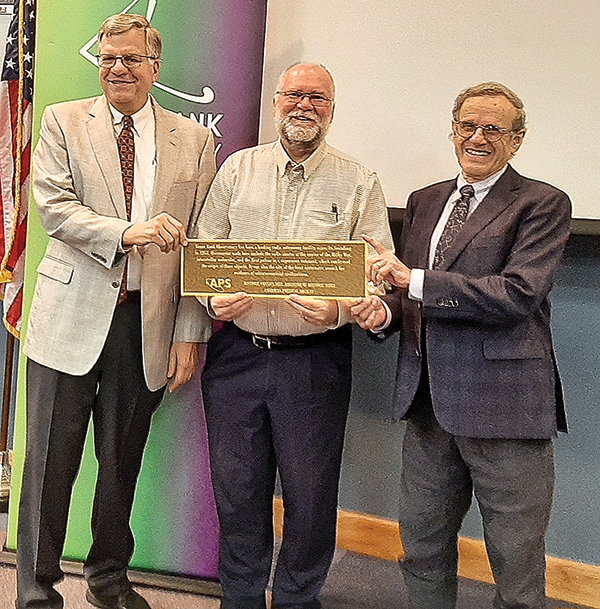
Heather Niday
Allegheny Mountain Radio
The Green Bank Observatory received a prestigious honor September 27 when the CEO of the American Physical Society presented a plaque to Site Director Dr. Jim Jackson, recognizing the historic contributions the observatory has made to the field of astrophysics and astronomy.
“I’m John Bagger, and I’m the CEO of the American Physical Society, and I am delighted to be here today,” he said. “It was just such a beautiful drive in yesterday. Thank you, Green Bank Observatory, for hosting this very special event. The American Physical Society is one of the world’s largest organizations of physicists and astronomers, representing more than fifty-thousand members across universities, laboratories and industry. We’re brought together by our shared mission which is to advance and diffuse the knowledge of physics for the benefit of all.”
Bagger said in 2005, the committee on historic sites was formed to formally recognize sites with historical importance to the physics enterprise. He said by designating sites as historic APS sites, they aim to acknowledge the scientific accomplishments and to celebrate the people and places that shape the direction of the field of physics. The committee solicits nominations for sites from their membership. Those sites are then winnowed down to a small number of sites each year that are recognized for their historic contributions.
Joining Bagger in the presentation ceremony was Robert Rosner, the current President of the APS, who praised the observatory for the work being done by the site.
“So the science being done here is really broad ranging and exciting and I think it is truly ‘out of this world,’” he said. “Under Jim’s leadership, the Green Bank Observatory continues to write the story of our universe. Today, it’s my honor to dedicate the Green Bank Observatory as an APS historic site with the following citation.”
“Green Bank Observatory has been a leading radio astronomy facility since its founding in 1957. The discoveries made here include the radio source at the center of the Milky Way, interstellar molecules, and the first pulsar in a supernova remnant which confirmed the origin of these objects. It is also the site of the first systematic search for evidence of extraterrestrial civilizations.”
GBO Site Director Dr. Jim Jackson accepted the award while highlighting some of the discoveries made at Green Bank.
“Green Bank has made many fundamental contributions to the history of radio astronomy and physics, including the Drake Equation, which is an estimate of the number of communicating extraterrestrial civilizations. That equation was formulated over some wine, I think and some beer in the Drake Lounge [in the residence hall on site] and there’s a plaque commemorating that momentous event.”
Jackson said the GBO also created the Tully-Fisher method, providing a cosmic “yardstick” for measuring the vast distance between galaxies and to better understand the structure of the universe. In addition to the many, many discoveries credited to Green Bank, Jackson said he’s also very proud that this site was the first public, national observatory ever founded.
“Before that, observatories were private, and you had to be privileged to use telescopes,” he said. “Green Bank [and] the NRAO [National Radio Astronomy Observatory] changed that model in 1957. We only accept the best science. We don’t care who writes the proposals, where you’re from; we evaluate the scientific idea and if the scientific idea has merit, we will do those observations. And I think the great success that we’ve had as an observatory is due in no small part to that policy.”
Jackson said he hopes the APS designation will not only help to introduce the GBO to APS members from around the world, but also to the future generations of STEM professionals so critical to the continuing success of the observatory.



